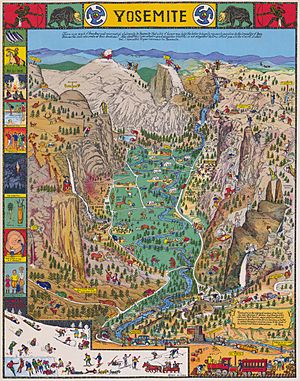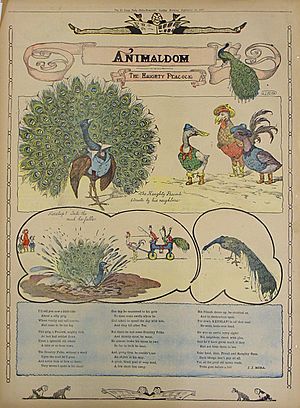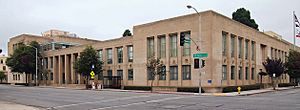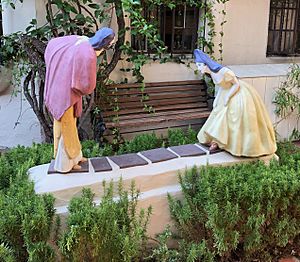Jo Mora facts for kids
Quick facts for kids
Jo Mora
|
|
|---|---|

Jo Mora
|
|
| Born |
Joseph Jacinto Mora
October 22, 1876 |
| Died | October 10, 1947 (aged 70) |
| Nationality | Uruguayan-born American |
| Known for | Painting, drawing, sculpture, muralist |
| Style | Realism |
| Spouse(s) | Grace Needham |
Joseph Jacinto Mora (born October 22, 1876 – died October 10, 1947) was a talented artist from Uruguay who became an American citizen. He was many things: a cowboy, photographer, cartoonist, painter, and sculptor. He even lived with the Hopi people and wrote about his time in California. People often called him the "Renaissance Man of the West" because he was skilled in so many different areas.
Contents
Early Life and Art Studies
Jo Mora was born in Montevideo, Uruguay, on October 22, 1876. His father, Domingo Mora, was a sculptor from Spain. His mother, Laura Gaillard Mora, was a smart woman from France. Jo's older brother, F. Luis Mora, also became a famous artist.
In 1880, Jo's family moved to the United States. They first lived in New York City and then in Perth Amboy, New Jersey. Jo studied art at the Art Students League of New York and the Cowles Art School in Boston. He also learned from a famous painter named William Merritt Chase.
Jo started his career as a cartoonist. He drew for newspapers like the Boston Evening Traveller and the Boston Herald.
Exploring the American West
In the spring of 1903, Jo Mora traveled to Solvang, California. He stayed at a ranch there and planned to explore the Southwest. He wanted to paint and photograph the Hopi people. He also visited Mission Santa Inés, and his photos from there are now kept at the Smithsonian Institution.
That summer, Mora rode his horse to many Spanish missions in California. He followed the "Mission Trail," also known as the "Kings Highway."
From 1904 to 1906, Mora lived with the Hopi and Navajo tribes near Oraibi, Arizona. He took many photographs and painted pictures of their daily lives. He even recorded the famous Hopi Snake Dance. Mora learned their languages and drew detailed pictures of everything he saw.
Artistic Career
In 1907, Jo Mora returned to California and married Grace Needham. Their son, Joseph Needham Mora, was born in 1908. The family moved to San Jose, California, where Jo continued his art.
In 1911, a building in San Francisco was dedicated. It had six clay panels made by Jo Mora and his father, Domingo Mora. In 1915, Jo was part of the judging team at the Panama–Pacific International Exposition. He also showed six of his sculptures there.
Mora created several important sculptures. In 1915-16, he made a bronze memorial for Archbishop Patrick W. Riordan. He also created the Cervantes Monument in San Francisco's Golden Gate Park. By 1919, he was sculpting for the Bohemian Club, including the Bret Harte Memorial plaque.
Life in Carmel-by-the-Sea
In 1921, the Mora family moved to Carmel-by-the-Sea, California. This town was a big art center on the West Coast. Jo built a Craftsman-style home there, which became their main residence.
Mora was asked to create a bronze and stone monument for Father Junípero Serra. This monument is in the Memorial Chapel at Mission Carmel.
Jo Mora was also on the board of directors for the Carmel Art Association. His sculptures were shown there between 1927 and 1934. He also helped start Carmel's first art gallery run by local artists.
During the Great Depression, Mora helped Carmel's community. He designed the "Carmel Dollar." This was a special paper money given to unemployed people for public service. They could use it to buy food and other important things.
Architect Robert Stanton worked closely with Mora on many projects. In 1937, Stanton designed the Monterey County Courthouse. Mora created the detailed panels, column tops, and figures for both the outside and inside of the building.
In 1922, for the opening of the Carmel Woods neighborhood, Mora carved a wooden statue of Padre Junípero Serra. It was placed in a small shrine at the entrance to the area.
In 1925, Mora designed a special half-dollar coin for California's Diamond Jubilee. He also illustrated many books, painted large murals, and created maps and diagrams of the American West. Starting in 1937, Mora wrote and illustrated children's books about the West. In 1939, his sculptures were added to the King City High School Auditorium building as part of a government project.
Pebble Beach and Big Projects
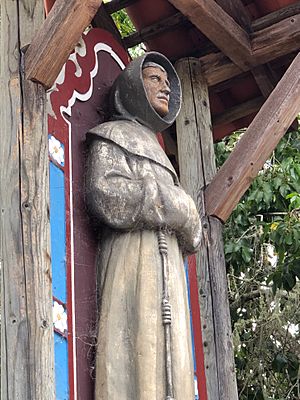
In 1931, Jo, his wife, and their daughter Patricia moved to Pebble Beach. Five years later, in his large studios, he finished a huge diorama. This was called Discovery of the San Francisco Bay by Portola. It was made for the California Pavilion at the 1939-40 Golden Gate International Exposition.
This diorama was almost 100 feet long! It had 64 sculptures of Spanish explorers and Native Americans, plus over 200 animals. People said it was the best of its kind at the Fair. Mora also made smaller dioramas for the Will Rogers Memorial Museum in Oklahoma and the Sutter's Fort Museum in California.
"El Paseo" Sculpture
In 1928, Mora created the "El Paseo" sculpture. It is in the courtyard of the El Paseo Building in Carmel. The building is now a protected historic site.
"El Paseo" is a clay sculpture of a Californio man and a Señorita woman.
In the early 1930s, Mora was asked to decorate the Carmel Dairy Building. He made three large murals inside the dairy. He also sculpted a metal lamp shaped like a cowbell, which still hangs above the front door. He drew animal figures dressed as humans, many of whom looked like local Carmel residents. He also designed menus, Christmas cards, and milk bottles with these animal characters.
Jo Mora's sculptures, illustrations, and paintings were shown in many places across the United States from 1908 until the late 1940s.
Later Life and Legacy
Jo Mora passed away on October 10, 1947, in Monterey, California. His last book, Californios, was published after his death. It was about the lives of ranch owners in early California.
In Music
- Jo Mora's 1933 poster, "Evolution of the Cowboy," was used to promote the California Rodeo Salinas. Later, in 1950, parts of it were used in Levi Strauss & Co. advertisements. The image of the Sweetheart of the Rodeo from the poster was even used on The Byrds' 1968 album Sweetheart of the Rodeo.
- The Western singer Mike Beck has a song about Mora called "In Old California."
Coin Design
Mora designed the 1925 California Diamond Jubilee half dollar coin.
Works on the National Register of Historic Places
- Monterey County Court House, Salinas, CA. This 1937 building is important for its architecture and the artwork by Jo Mora.
- Mission San Carlos Borromeo Del Rio Carmelo, Carmel, CA. This mission features Father Junipero Serra’s monument, an altar cross, and a sculpture by Mora.
Images for kids


